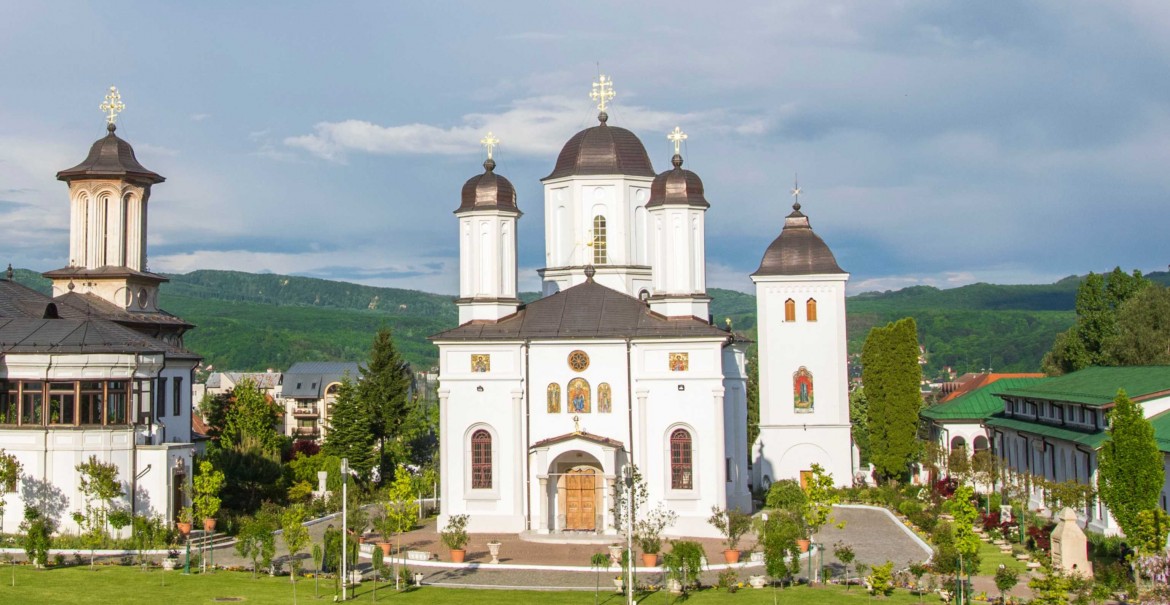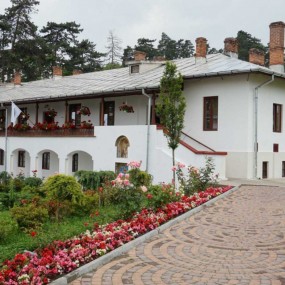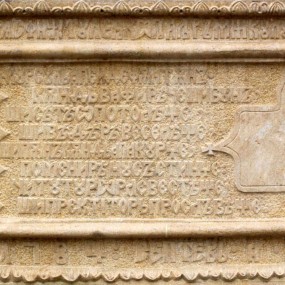Catedrala Arhiepiscopală / Archbishopal Cathedral / Cathédrale de l'archevêque / Die Kathedrale
Catedrala Arhiepiscopală din Râmnicu Vâlcea, cu hramul istoric Sfântul Ierarh Nicolae, a fost construită pe temelia unor biserici mai vechi.
Se crede că prima biserică, cea mai veche, a fost construită spre sfârșitul secolului al XIV-lea, foarte probabil de către Voievodului Dan I (1383-1386), fratele lui Mircea cel Bătrân.
A doua biserică a fost zidită pe locul celei dintâi între anii 1576-1586, de către Episcopul Mihail al II-lea. Aceasta a fost refăcută de Voievodul Matei Basarab (1632-1634), dar a fost arsă și dărâmată de turci în timpul războiului pe care aceștia l-au avut cu austriecii (1736-1737).
A treia biserică, zidită pe același loc, a fost ctitorită de Episcopul Climent, cândva între anii 1737-1745, dar și aceasta a căzut pradă unui mare incendiu, care a cuprins orașul Râmnic în Duminica Învierii din anul 1847.
Actuala biserică a fost ctitorită de către Sfântul Calinic de la Cernica, Episcopul Râmnicului, între anii 1850-1856. Ea a fost proiectată și construită de ucenicii Sfântului Calinic, care au zidit și bisericile Sfintelor Mânăstiri Cernica, Pasărea şi Frăsinei, foarte asemănătoare între ele. Dintre acești ucenici arhitecți, cel mai însemnat a fost meșterul Costache. La construirea acesteia a contribuit financiar și Barbu Dimitrie Știrbei, Domnul Țării Românești.
Biserica este zidită în formă de cruce, fiind încununată cu trei turle, una centrală, de mari dimensiuni, şi două frontale, mai mici.
Biserica a fost pictată în ulei, în stilul realist al Renaşterii, între anii 1854-1855, de către pictorul român Gheorghe Tattarescu.
Catapeteasma este sculptată în lemn masiv de tei, în stil gotic, și poleită cu aur.
Archbishopal Cathedral
Archbishopic Cathedral in Râmnicu Vâlcea, with historical hoSt. Hierarch Nicolae, was built on the foundation of older churches.It is believed that the first church, the oldest was built towards the end of the 14th century, very likely by Voivoder Dan I (1383-1386), Mircea the Elder's brother.
The second church was built on the place of the first between 1576-1586 by Bishop Mihail II. This was restored by Mathei Basarab (Voivode of Batarab (1632-1634), but burned and denied by the Turks during the war that they had with the Austrians (1736-1737).
The third church, built on the same place, was founded by the bishopCliment.Once sometime between 1737-1745, but this has fallen prey to a great fire, which included the Rânenic city in Sunday of the resurrection since 1847.
The current church was founded by the Holy Calinic in Cernica, the Bishop of Râmnic,Between 185-1856. It was designed and built by the Holy Calinic disciples, which also built the churches of the Holy Cernica monasteries, Pasărea and Frăsinei very similar to each other. Of these architectural disciples, the most important was Costache's craftsman. To the construction had a financial contribution Barbau Dimitrie Ştirbei, the Lord of the Romanian country.
The church is built in the form of cross, being into acount that the in the front there were two complicated central turnes, of large size,andTwo front, smaller front.
The church was painted in oil in the realistic style ofRenaissance, between 1854-1855, by the Romanian painter Gheorghe Tattrescu.
The iconostasis is carved in massive wooden, in Gothic style, and gold-poled.
Cathédrale de l'archevêque
La cathédrale de l'archevêque de Râmnicu Vâlcea, avec le patron historique Saint Hiérarque Nicolas, a été construite sur les fondations d'églises plus anciennes. On pense que la première église, la plus ancienne, a été construite vers la fin du XIVe siècle, très probablement par le voïvode Dan I (1383-1386), le frère de Mircea l'Ancien. La deuxième église a été construite sur le site de la première entre 1576-1586, par l'évêque Mihail II. Il a été reconstruit par le voïvode Matei Basarab (1632-1634), mais il a été incendié et démoli par les Turcs pendant la guerre qu'ils ont eue avec les Autrichiens (1736-1737).
La troisième église, construite sur le même site, a été fondée par l'évêque Climent, entre 1737 et 1745, mais elle a également été la proie d'un grand incendie qui a englouti la ville de Râmnic le dimanche de la Résurrection en 1847.
L'église actuelle a été fondée par saint Calinic de Cernica, évêque de Râmnic, entre 1850-1856. Il a été conçu et construit par les disciples de Saint Calinic, qui ont également construit les églises des Saints Monastères Cernica, Pasărea et Frăsinei, très similaires les unes aux autres. Parmi ces apprentis architectes, le plus important était l'artisan Costache. Barbu Dimitrie Știrbei, seigneur de la terre roumaine, a également contribué financièrement à sa construction.
L'église est construite en forme de croix, couronnée de trois tours, une centrale, grande, et deux frontales, plus petites.
L'église a été peinte à l'huile, dans le style réaliste de la Renaissance, entre les années 1854-1855, par le peintre roumain Gheorghe Tătărescu.
L'iconostase est sculptée en bois de tilleul massif, dans le style gothique, et poli à l'or.
Die Kathedrale
Die Erzbischöfliche Kathedrale in Râmnicu Vâlcea, die das historische Patronat des Heiligen Hierarchen Nicolae trägt, wurde auf den Fundamenten älterer Kirchen errichtet. Es wird angenommen, dass die erste Kirche, die älteste, vom Ende des 14. Jahrhunderts stammt, höchstwahrscheinlich aus der Zeit des Woiwoden Dan I. (1383-1386), dem Bruder von Mircea dem Älteren.
Die zweite Kirche wurde zwischen 1576 und 1586 von Bischof Michael II. an der Stelle der ersten erbaut. Sie wurde vom Woiwoden Matei Basarab (1632-1634) wiederaufgebaut, aber von den Türken während des Türkisch–Österreichischen Kriegs (1736-1737) niedergebrannt und zerstört.
Die dritte Kirche, die an derselben Stelle errichtet wurde, wurde von Bischof Climent zwischen 1737 und 1745 gegründet, fiel aber ebenfalls einem großen Brand zum Opfer, der am Ostersonntag 1847 über die Stadt Râmnic hinwegfegte.
Die heutige Kirche wurde vom heiligen Calinic von Cernica, Bischof von Râmnic, zwischen 1850 und 1856 erbaut. Sie wurde von den Schülern des Heiligen Calinic entworfen und gebaut, die auch die Kirchen der Klöster Cernica, Pasărea und Frăsinei errichteten, die sehr ähnlich sind. Der wichtigste dieser Architektenlehrlinge war der Handwerker Costache. Barbu Dimitrie Știrbei, Herr des Rumänischen Landes, trug ebenfalls finanziell zum Bau bei.
Die Kirche ist in Form eines Kreuzes gebaut und wird von drei Kirchtürmen gekrönt, einem großen in der Mitte und zwei kleineren an der Vorderseite. Sie wurde zwischen 1854 und 1855 von dem rumänischen Maler Gheorghe Tattarescu in Ölmalerei im realistischen Renaissancestil ausgemalt.
Die geschnitzte Decke im gotischen Stil ist aus massivem Lindenholz geschnitzt und mit Gold verziert.










